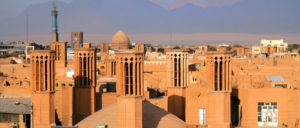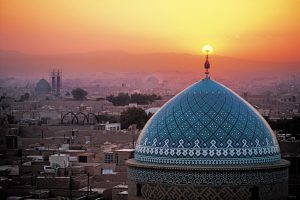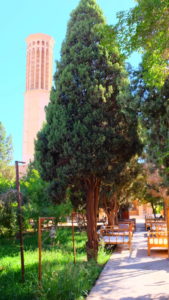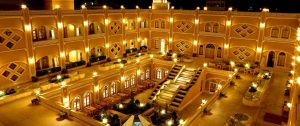I first went to Yazd in mid-summer 2016. We arrived on an overnight train from Kashan in the early morning. The beautiful city of Yazd was still sleeping. It was day 6 of our intense 12-day vacation and we were in need of rest too.
My best memories of Yazd are from that morning, wandering around the back streets and alleys of the old town, getting thoroughly lost. There was no one about, except for the street cats and crows. Exploring through a maze of streets, lined with mud-brick buildings felt surreal.
A couple of hours later the city started to stir, some cafes opened and we grabbed a coffee whilst our other travel companion got a hair cut at a Yazdi style barbershop. Our time in Tehran and Kashan had been so hectic – tours, sightseeing, and desert adventures. As soon as we arrived in Yazd this flurry left us. We entered relax-mode, keeping pace with the Yazdi locals.

Yazd skyscape complete with domed roofs and badgirs (wind catchers)
The city itself is a lot more beautiful than some Iranian cities. There’s the old town (mud brick) and crumbling. Most of the buildings in the new town are built in the same architectural style – low set structures made of long thin cream bricks with lots of archways and turquoise-colored tiles. Be sure to seek out an opportunity to climb to a vantage point (like a tall building or tower) so you can grasp the surrounds. From above you will see domed roofs and earth-colored buildings stretching to the city limits and the mountains beyond.
Generally speaking, Yazd is more conservative and religious than some Iranian cities like Tehran, Shiraz or Northern Iran. Around half the women wear a chador and I saw a tonne of Khamenei paraphernalia like tributes in shops and even mobile phone covers depicting Iran’s Supreme Leader.
There is plenty to see and do when you travel to Yazd. If you have the time, I’d recommend spending more than 1 day in Iran’s famous desert city. Whether you have 24 hours or 24 days, here is a list of popular things to see and do.
Read more about Yazd in our post: Yazd: The Eternal Civilization.

Jameh Mosque of Yazd
Top sites in Yazd
Apart from wandering through the old city, there are some really special sites in and around Yazd. Yazd is quite small so walking in between these places is totally do-able. Visitors to Yazd will see a lot of religious (both Zoroastrian and Islamic) monuments and marvel at the ingenious of the ancient people who managed to thrive in this harsh environment.
Jameh Mosque of Yazd is a mosaic masterpiece. Believed to have been a Zoroastrian fire temple prior to the Islamic invasion, the site has always been a place of spiritual significance. Located close in the center of town, checking out the Jameh Mosque is highly recommended.
The Water Museum is another interesting attraction. This place basically explains how people have survived in the desert city of Yazd for err, more than 2,500 years! The museum offers information about the qanat technology – an underground water well system similar to (but predating) the aqueduct.
Across the road from the Water Museum is the Amir Chakhmaq Historical Complex. This is one of the most famous and visited monuments in Yazd. Amir Chakhmaq is basically a mosque, a bathhouse and a bunch of museums set around a beautiful square. Surrounding the complex are a handful of touristy shops and one of the best pastry joints in t

Dolat Abad, home to Iran’s tallest wind catcher – Yazd, Iran
own! Many tourists come here at sunset because of the light dances across the buildings – magical!
Dolat Abad Garden, just slightly north of the city
center, is an exemplary Persian Garden. Established by an 18th Century king, it is home to Iran’s tallest badgir (wind catcher). These badgirs work as air-conditioning, essentially catching the wind and circulating cool air into the lower chamber where there is usually a pond. You can actually get cold sitting under a badgir, even when its 40 degrees Celsius outside! The garden also has few old buildings with ornate stained-glass windows. There is an onsite cafe and traditional style day beds (takht) to lounge about on.
Many visitors to Iran seek out the Zoroastrian sites, as such the Zoroastrian fire temple in Yazd is a popular destination. Zoroastrianism was first practiced in Iran and is one of the world’s oldest continuing religions. Some Zoroastrian festivals (like Nowruz) continue to be a celebrated part of Iranian culture today. One of the main premises of the religion is that “active and ethical participation in life through good deeds formed from good thoughts and good words is necessary to ensure happiness and to keep chaos at bay”. Today, the number of Zoroastrians in Iran is less than 1% of the population but Yazd is home to a relatively large Zoroastrian community. Visiting the Yazd fire temple is a sure way to learn more about the Zoroastrian faith. Oh, and you’ll also see a fire that has been burning for over 1,500 years!
Where to stay in Yazd
Yazd has a tonne of top-notch accommodation options. I recently stayed at Dad Hotel in the center of town. Dad Hotel is a tastefully converted caravanserai with a gorgeous central courtyard and accessible rooftop. The rooms are spacious and some even have their own fireplace and stain-glass windowed dome. There’s a free buffet breakfast and swimming pool too.
If you’re wanting a different experience Nartitee Ecolodge is the perfect place for travelers to relax. Located just 20 kilometers outside of Yazd, Nartitee Ecolodge offers simple, traditional-style rooms and home-cooked meals. Nartitee’s philosophy encourages visitors to rest and rejuvenate during their stay. They also offer a bunch of ecotourism and agriculture tours of the area.
To browse all Yazd hotels visit 1stQuest or read 10 of the best historic hotels in Yazd.

Hotel Dad in Yazd exemplifies the beauty of Persian design
What to eat in Yazd
The street food in this city is great. You can basically walk along the street and snack. The most memorable bread I’ve ever eaten was here. It was a local flatbread variety made with wholemeal flour with a tonne of grains and saffron. Delicious, or khosh-maz-eh as they say in Farsi!
One of the local specialties is sweets, pastries, and cakes. The collective word for this kind of yummies in Persian is shirini, which translates to sweetness.

Cake Yazdi – a rosewater and cardamom cupcake delight
The streets of this city are lined with bakeries baking fresh goods all day long. Coconut biscuits, Persian fairy floss, cupcakes in rosewater syrup, brownies … the list goes on.
Upon the recommendation of a local, we ate lunch at Talar e Yazd Restaurant which was a bit out of town but sooooo Iranian, well priced and delicious. They do all kinds of kebab and khorest (curry/stew). I had the gheimeh badamjoon, a beef curry with eggplant and lentils which is served with rice. Termeh and Toranj Restaurant has a lovely ambiance and also serves traditional foods. Cafe Fooka is another popular choice and serves great coffee.
Wanna know more about Iranian food? Check out: The most delicious Iranian cuisine not to be missed…
Getting to Yazd
Getting around Iran is super easy and getting to Yazd is no exception.
You can catch a bus, train, plane or hire a driver to get to this city from all major Iranian cities. It is located about 6 hours southeast of Tehran or 3.5 hours northeast of Isfahan. However, the most popular route is to catch a bus from Shiraz to Yazd as most travelers head south from Tehran to Kashan, Isfahan, and Shiraz and loop back to Tehran via this city. Geographically this makes a lot of sense.
Check out 1stQuest.com for online booking of transport in Iran.
